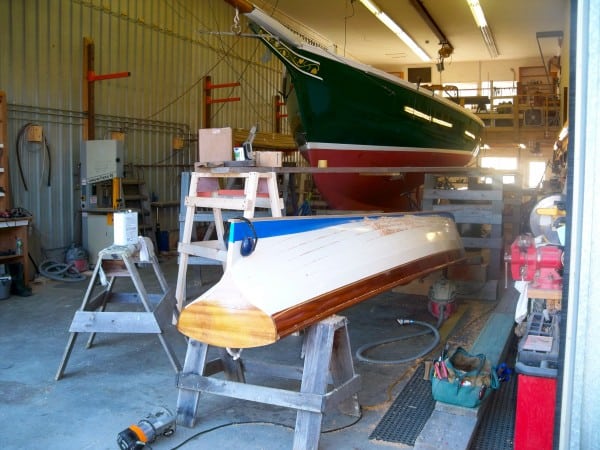 Here is a great reason why I am having so much fun with this walkabout post. Midweek I says to myself, “Hey self, why don’t you go have a look at what else is going on around here.” I was enamored of the scene I found in the service bay. JABBERWOCKY is a beautiful Friendship sloop and, while not built of wood, she was made from a mold taen from an original named DICTATOR built by Rob McLain on Bremen Long Island around 1904. I feel this is one of the most handsome designs of the type. In front of JABBERWOCKY is a sweet little lapstrake whitehall that’s in for a new oak keel shoe. While I spend six months to a year building a single new boat, the guys in service bay get to see many.
Here is a great reason why I am having so much fun with this walkabout post. Midweek I says to myself, “Hey self, why don’t you go have a look at what else is going on around here.” I was enamored of the scene I found in the service bay. JABBERWOCKY is a beautiful Friendship sloop and, while not built of wood, she was made from a mold taen from an original named DICTATOR built by Rob McLain on Bremen Long Island around 1904. I feel this is one of the most handsome designs of the type. In front of JABBERWOCKY is a sweet little lapstrake whitehall that’s in for a new oak keel shoe. While I spend six months to a year building a single new boat, the guys in service bay get to see many.
. . . sign up to the right to get immediate access to this full post,
plus you'll get 10 of our best videos for free.
Get Free Videos& Learn More Join Now!!for Full Access Members Sign In


Thomas Miller says:
I want to make a carbon fiber Gin pole
I have read of carbon fiber “socks” and have a role of carbon fiber used in aircraft construction
.
Any recommendations
Dennis Dunn says:
Eric:
Speaking of hardening too soon … how do you mix up such large quantities of epoxy without it kicking off too soon. Do you use a very slow hardener? Thanks.
-Denny
dunn@cse.psu.edu
Peter Marshall says:
eric,
what part does the shade fabric play in the process?
Eric Blake says:
Peter,
The shade cloth is actually the layer in which the resin flows through under vacuum. The coarse weave of this fabric allows resin to move through it, as it wets out the carbon below it. This layer moves the epoxy towards the next resin feed line. Without it the resin would travel far to slowly and run the risk of hardening before reaching the next feed line.